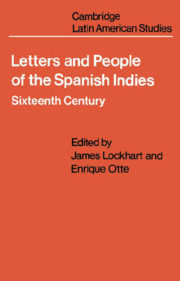Book contents
- Frontmatter
- Contents
- Preface
- Part I Conquest
- Part II The Variety of Life in the Indies
- Part III officials and Clerics
- 29 How a governor operates
- 30 Alarm and drastic remedies: A viceroy's view of New Spain
- 31 The concerns of a judge
- 32 bishop and the governor
- 33 A bishop's affairs
- 34 Franciscans and the Indians
- 35 The Dominican attack
- 36 The Franciscan reply
- 37 The petty administrator
- 38 The parish priest
- Bibliography
- Index
38 - The parish priest
from Part III - officials and Clerics
Published online by Cambridge University Press: 06 August 2018
- Frontmatter
- Contents
- Preface
- Part I Conquest
- Part II The Variety of Life in the Indies
- Part III officials and Clerics
- 29 How a governor operates
- 30 Alarm and drastic remedies: A viceroy's view of New Spain
- 31 The concerns of a judge
- 32 bishop and the governor
- 33 A bishop's affairs
- 34 Franciscans and the Indians
- 35 The Dominican attack
- 36 The Franciscan reply
- 37 The petty administrator
- 38 The parish priest
- Bibliography
- Index
Summary
Bachelor Francisco de la Calzada, in Potosi, to his sister Maria de la calzada in Valencia de Don Juan, old Castile, 1577
… The priests and friars who have a nephew whom they can trust are very rich …
Bachelor Calzada gives us in this letter a good object lesson in the economic situation of the secular clergy. The regular orders had general funds, endowments and estates which could shield friars from overt individual activity for economic gain. But secular priests were practically free agents, with no institutional support, and calzada is not exaggerating much when he says their salaries were ‘not enough for drinking water.’ Even to maintain himself in the style the community expected, much less to save anything for retirement, a priest had to have supplementary sources of income. One of the best such sources was a chaplaincy, paying the priest from an endowed fund for saying periodic masses on behalf of the patron. These plums, however, went largely to relatives of the encomenderos and other prominent local people who endowed them. Priests in the countryside commonly worked for their encomenderos as trusted, high-level managers or inspectors, and also began to acquire estates of their own; in towns they invested in whatever was most likely to show a profit, whether commerce, real estate, or here, mines. They ordinarily received certain supplies and labor from the Indians in addition to their salaries, from the same source as encomienda tribute, and indeed the encomenderos were long responsible for seeing that they got it. The products and services were often not of a kind they could use directly; instead they sold the products and employed the labor on their estates. In this way they acquired capital for more lucrative enterprises within the Spanish sector of the economy. These additional emoluments are the ‘rations’ that calzada refers to as being worth 2,000 pesos a year, far more than the salary proper, and that the viceroy has taken away. This measure, had it stuck, would have been the death of Christianity in Peru; but it did not, and rural priests especially continued receiving their rations, in Peru as elsewhere, until the end of the colonial period.
Calzada's ambition is to buy a refining mill using ‘this new invention of mercury.’ Even at Potosi the richest deposits, those which could be exploited through smelting, were not inexhaustible.
- Type
- Chapter
- Information
- Letters and People of the Spanish IndiesSixteenth Century, pp. 252 - 256Publisher: Cambridge University PressPrint publication year: 1976



